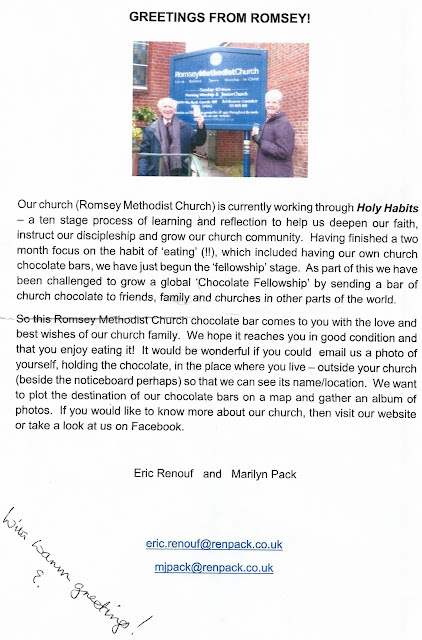House 12 PTC campus has been busy with guests passing through for a few nights. Thank you Mercy and Josiah for the blessing of your company...
...also Ronald and Anne Clements whose visit included a Friday morning and the opportunity to share in the weekly Education by Extension tutorial.
17-18th March was a huge couple of days in College, as the Church History Department led a 500 years of Reformation event. I'll let them explain, using the text that was on their publicity...
500 YEARS OF REFORMATION – A CELEBRATION
We are liberated by God’s grace
These words go to the heart of the gospel of Jesus Christ and to the soul of the Lutheran Reformation. They are linked to Luther’s key insight that helped trigger the Reformation – Christians attain salvation only by the grace of God. We call this justification by faith alone.
“Liberated by God’s Grace” is the main theme of our celebrations surrounding the 500th anniversary of the Reformation in 2017. It will also be the theme of the 2017 Assembly of The Lutheran World Federation in Windhoek, Namibia. All our celebrations, worship, study and engagement will focus on how the gracious love of God, through the life and ministry of Jesus Christ, opens up opportunities for us as faithful Christians to reach out as healers and reconcilers to a world torn apart by strife and inequality.
Workshops offered by the four PTC departments:
Theology and Ethics: Luther's Theology of Creation and Climate Change in the Pacific
Dr Davis will offer an exposition of the key points of Luther's doctrine of creation and discuss this in relationship with the issue of climate change in the Pacific. While climate change was unknown to Luther, key aspects of his theology speak to the issue today, including his theology of the cross and his criticisms of indulgences and humanity's misuse of creation. Finally, the shortcoming of Luther's theology in dealing with climate change in the Pacific will be addressed as a prod to Pacific theologians to do their own theological work on this pressing issue.
Dr Vaai focuses on employing the relational hermeneutical approach fundamental to the Pacific way of thinking and life to reconstruct a relational theology based on Luther’s Reformation teachings to effectively inform eco-justice talanoa and address issues affecting the Pacific vanua such as climate change.
Biblical Studies: Sola Scriptura!? Luther's Biblical Hermeneutics
The workshop will offer a brief introduction to the topic, followed by a discussion based on short texts by Luther. It will centre on three questions: What did Martin Luther mean by "sola scriptura" (by Scripture alone)? How has this influenced hermeneutical strategies ever since? What sense does this make in Pacific Island contexts today?
Church and Ministry: Priesthood of all Believers –
A relevant Option for Ministry in the Pacific today?
‘Priesthood of all Believers’ – a hallmark of Luther’s Reformation – has always been a challenge, first to the Roman Catholic Church and later to the Protestant Churches.
What light does ‘Priesthood of all Believers’ shed on sharing power and authority in the church? Should we redefine titles and ranks in this light? What is the meaning of a church office, when all are called to be priests? What actually does ‘priesthood’ mean to me and my work today? Participants are invited to voice out such questions and, in response, share their related experi-ences and visions.
Church History: Demonizing Dissenters
The workshop will look at the “dark side” of Luther: the excessive, at times outrageous polemics against his opponents, its reasons and its consequences. Luther’s experience of the devil will be highlighted as important background to understanding his enormous resilience, and also his of-fensive behaviour and language. Questions concerning the meaning of the devil and patterns of demonization in the pacific context may lead to discussion.
My humble role in all this was to introduce PTC's Principal the Revd Professor Dr Feleterika Uili Nokise as one of the keynote speakers, get people into discussion groups afterwards, and facilitate a feedback session. Enlightening at many levels.
Hot on the heels of the Reformation 500 event came this one, hosted by our Institute of Mission and Research.
The Guest lecturer for the event was also the Principal of PTC. Sinning by way of 'lazy blogger' syndrome I steal my colleagues' publicity again...
...he will be delivering his lecture on the topic 'Wellbeing: Our capacity to imagine, express new possibilities, and find new solutions to complex issues'. The overall theme of the lecture series 'Churches in Conversation with Society on Issues that Matter' is an attempt to raise awareness and debate on an issue that is far reaching in its consequences to human existence – the ecological crisis. Pertinent to the issue is the question: what are the religious, traditional and cultural resources at our disposal that will help us with reweaving the ecological mat?
As well as being grateful for the events themselves, none would have been possible without the amazing, selfless sharing of the abundant resources and talents of the student community here who - as well as being required to engage academically with the events - prepared meals, decorated rooms, served guests, provided entertainment, set up sound systems, etc etc etc. It would be impossible to add too many 'etcs' to that sentence. Thank you community. You were and are stunning.
If you want a sample of the musical offerings, have a look at our PTC Youth Group in action. Brilliant!
And the PTCEE mail this week has included assignments posted from various islands, some registration forms, the phone bill... oh yes, and a bar of chocolate from Romsey Methodist Church.
PTCEE administrator Nisha kindly obliged with the photo as requested.Signage and location indicated.
Has our chocolate bar travelled the furthest?
Thanks Romsey!
(But in Lent, friends. Tut tut ...)
For Sunday consumption only!
Thanks Romsey!
(But in Lent, friends. Tut tut ...)
For Sunday consumption only!











